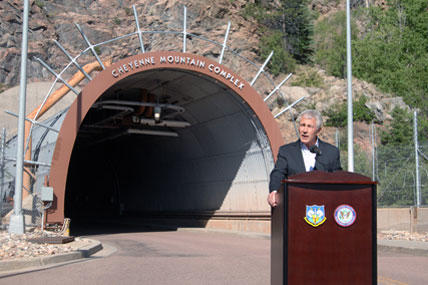China's defense minister, Gen. Chang Wanquan, arrived in Hawaii Friday for a series of high-level meetings with U.S. military officials that will include the first-ever visit by a major Beijing official to North American Aerospace Defense Command (NORAD).
The overall theme of Chang's first trip to the U.S. as defense minister was improving military-to-military contacts from the junior officer level on up, a senior U.S. Defense official said. The visit will conclude with a joint press conference with Defense Secretary Chuck Hagel at the Pentagon on Monday.
Chang's visit will also afford him an opportunity "to maintain what we see as a very positive momentum" in relations between the two militaries, the senior Defense official said at a background briefing.
Hagel and senior U.S. commanders were also expected to "have a robust exchange of views" with Chang on a range of issues including cybersecurity, the U.S. rebalance to Asia, the arms buildup in nations neighboring China and the ongoing dispute with Japan over uninhabited islets off China's coast, the official said.
In Hawaii, Chang was meeting with Adm. Samuel Locklear, head of the Pacific Command. At a Pentagon briefing last month , Locklear said the rapid growth of the People's Liberation Army and the Chinese navy as an opportunity or a grave threat to the U.S. "and I look at them as an opportunity. "
"If the opportunity is not realized, then, as it would be with any other growing military, it potentially, you know, could become a threat. But I certainly view it and approach it as an opportunity," Locklear said.
Locklear also noted that China has accepted the U.S. invitation to attend next year's Rim of the Pacific Exercise, the world's largest international naval exercise, which will take place in waters off Hawaii.
Over the weekend, Chang will visit the NORAD near Colorado Springs for talks with Army Gen. Chuck Jacoby, head of the Northern Command.
At the Strategic and Economic Dialogue between the U.S. and China in Washington last month, the U.S. sought to minimize China's concerns about President Obama's plan to rebalance U.S. forces to the Pacific, which is viewed by Beijing as a move to counter to its influence in the region.
At the Dialogue, the two nations agreed to "actively explore a notification mechanism for major military activities and to continue discussions on the rules of behavior for military air and maritime activities."
However, China's official press said the dialogue agreement raised more questions than it answered: "Does that include the U.S. deployment of troops or weapons systems on China's periphery as part of its rebalancing to Asia? Does it include anti-satellite missile tests?"
The China Daily commentary also asked: "On the rules of behavior for military air and maritime activities, does this include U.S. reconnaissance in China's exclusive economic zone and the Chinese naval flotilla's unannounced but legitimate passage through the Straits of Japan?"
At the Pentagon briefing, the senior Defense Department official played down China's concerns about the arms buildup by China's neighbors, but the official media in Beijing railed against the launchings last week of an aircraft carrier by India and a destroyer that looked more like a helicopter attack ship by Japan.
The launching by India of the carrier Vikrant, which was expected to be operational in 2018 "reminds us that the strategic significance of developing aircraft carriers in Asia is not declining," the Global Times, China's Communist party newspaper, said in an editorial.
"The earlier China establishes its own aircraft carrier capabilities," the editorial said, "the earlier it will gain the strategic initiative."
China's first aircraft carrier, the Liaoning, an upgraded version of the Soviet carrier the Varyag, went on sea trials last year, but the Vikrant was built in Indian shipyards.
China reserved its harshest criticism for Japan's launch of the $1.1 billion Izumo, an 813-foot ship that Japan called a "helicopter carrier-type escort/destroyer."
The Izumo, expected to join Japan's Maritime Self-Defense Force in 2015, can accommodate 14 helicopters on its flight deck and can be adapted to take on the F-35B version of the Joint Strike Fighter that Japan is seeking to buy from the U.S.
Chinese media noted that Izumo, Japan's largest warship since World War II, was the name of the cruiser that led Imperial Japan's navy in attacks on Shanghai in 1937.
Zhang Junshe, a senior researcher at the People's Liberation Army Naval Military Studies Research Institute, told the state-run China Daily that "It is an aircraft carrier, and Japan just called it a helicopter destroyer to downplay its aggressive nature."
An earlier version of this story said Chang would tour the nuclear bunker at Alternative Command Center under Cheyenne Mountain. Chang did not tour the bunker, but he did tour the NORAD and NorthCom headquarters at Peterson Air Force Base, Colo.






























